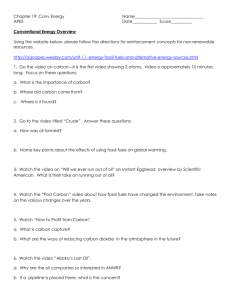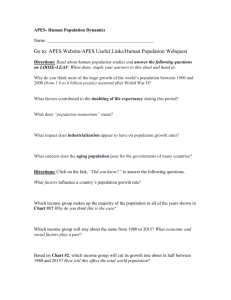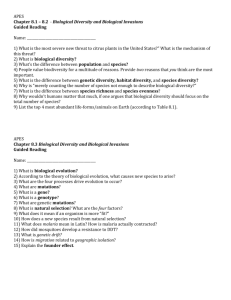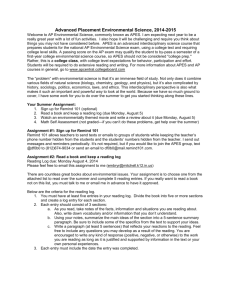AP-Environmental-Science-Summer-2014
advertisement
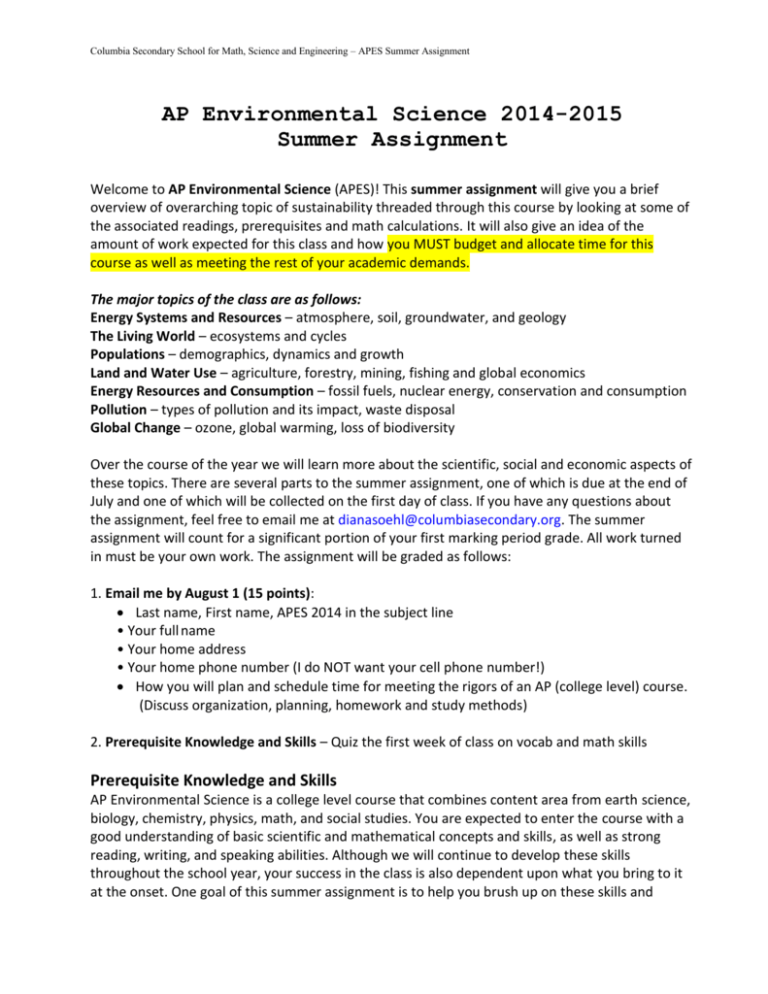
Columbia Secondary School for Math, Science and Engineering – APES Summer Assignment AP Environmental Science 2014-2015 Summer Assignment Welcome to AP Environmental Science (APES)! This summer assignment will give you a brief overview of overarching topic of sustainability threaded through this course by looking at some of the associated readings, prerequisites and math calculations. It will also give an idea of the amount of work expected for this class and how you MUST budget and allocate time for this course as well as meeting the rest of your academic demands. The major topics of the class are as follows: Energy Systems and Resources – atmosphere, soil, groundwater, and geology The Living World – ecosystems and cycles Populations – demographics, dynamics and growth Land and Water Use – agriculture, forestry, mining, fishing and global economics Energy Resources and Consumption – fossil fuels, nuclear energy, conservation and consumption Pollution – types of pollution and its impact, waste disposal Global Change – ozone, global warming, loss of biodiversity Over the course of the year we will learn more about the scientific, social and economic aspects of these topics. There are several parts to the summer assignment, one of which is due at the end of July and one of which will be collected on the first day of class. If you have any questions about the assignment, feel free to email me at dianasoehl@columbiasecondary.org. The summer assignment will count for a significant portion of your first marking period grade. All work turned in must be your own work. The assignment will be graded as follows: 1. Email me by August 1 (15 points): Last name, First name, APES 2014 in the subject line • Your full name • Your home address • Your home phone number (I do NOT want your cell phone number!) How you will plan and schedule time for meeting the rigors of an AP (college level) course. (Discuss organization, planning, homework and study methods) 2. Prerequisite Knowledge and Skills – Quiz the first week of class on vocab and math skills Prerequisite Knowledge and Skills AP Environmental Science is a college level course that combines content area from earth science, biology, chemistry, physics, math, and social studies. You are expected to enter the course with a good understanding of basic scientific and mathematical concepts and skills, as well as strong reading, writing, and speaking abilities. Although we will continue to develop these skills throughout the school year, your success in the class is also dependent upon what you bring to it at the onset. One goal of this summer assignment is to help you brush up on these skills and Columbia Secondary School for Math, Science and Engineering – APES Summer Assignment concepts. Over the summer, review the scientific vocabulary & concepts below (either by making online or actual flashcards, concept mapping, stories with terms in them) as well as the mathematical calculations on the next page; we will be building upon and referencing them throughout the school year. You should be prepared to take a quiz on these skills and concepts during the first week of school. If you do not receive at least an 85% on the quiz, you will need to stay after for tutoring until you are able to achieve an 85% on it. Prerequisite Basic Scientific Concepts: You should be familiar with the following terms/concepts from Biology, Chemistry, and Earth Science: Organic vs. Inorganic Natural vs. Synthetic Kinetic vs. Potential Energy Radioactive decay Half-life Law of Conservation of Matter 1st Law of Thermodynamics 2nd Law of Thermodynamics Entropy Organism Species Population Community Ecosystem Producers/Autotrophs Consumers/Heterotrophs Decomposers Photosynthesis (reactants and products) Cellular Respiration (reactants and products) Aerobic vs. Anaerobic Adaptation Mutation Gene Trait Chromosome Gene pool Natural Selection Biodiversity Extinction Plate Tectonics Weathering Climate Change Rocks vs. Minerals Climate vs. Weather The full name of each of these chemical abbreviations: CO2, CO, C6 H12 O6, CH4, H2, H2O, N2, NOx , NO3- , NH3 , O2 , O3, P, PO43- , S, SO2 , Cl, K, NaCl, Pb, Hg, Rn, U 3. Math Problems (40 points) – Due by Monday, August 25th - Drop it off in the main office, email, scan or snail mail it to CSS; be sure that both your name and my name are visible (grading: 2 points for setting up the problem, 2 points for the answer, 2 points for neatness) Prerequisite Basic Mathematical Skills Columbia Secondary School for Math, Science and Engineering – APES Summer Assignment Percentage 17% = 17/100 = .17 - Remember that “percent” literally means divided by 100. - Percentage is a measure of the part of the whole. Or part divided by whole. - 15 million is what percentage of the US population? 15 million / 300 million = .05 = 5% - What is 20% of this $15 bill so that I can give a good tip? $15 x .20 = $15 x (20/100) = $3 Percent change Percent increase and percent decrease are measures of percent change, which is the extent to which something gains or loses value. Percent changes are useful to help people understand changes in a value over time. Scientific Notation Thousand = 103 =1,000 Million = 106 =1,000,000 (people in the US) Billion = 109 =1,000,000,000 (people on Earth) Trillion = 1012 =1,000,000,000,000 (National debt) - When using very large numbers, scientific method is often easiest to manipulate. For example, the US population is 300 million people or 300x106 or 3x108 - When adding or subtracting, exponents must be the same. Add the numbers in front of the ten and keep the exponent the same. - When multiplying or dividing, multiply or divide the number in front of the ten and add the exponents if multiplying or subtract the exponents if dividing Ex. 9x106 / 3x102 = (9/3) x 10(6-2) = 3 x 104 Dimensional Analysis You should be able to convert any unit into any other unit accurately if given the conversion factor. Online tutorials are available: http://www.chemprofessor.com/dimension_text.htm http://www.chem.tamu.edu/class/fyp/mathrev/mr-da.html Prefixes m (milli) =1/1000 =10-3 c (cent) =1/100 =10-2 k (kilo) =1000 =103 M (mega) =1,000,000 =106 G (giga) =1,000,000,000 =109 T (tera) =1,000,000,000,000 =1012 Columbia Secondary School for Math, Science and Engineering – APES Summer Assignment Summer Study Sessions I will be available at the following times to discuss summer assignment questions and go over problems. You will receive a 15-point classwork grade for each session that you attend, though attendance is not mandatory. Both sessions will meet at CSS (Basement Chemistry room). Wednesday July 16th 10:00am - 12:00 Wednesday, August 25th 11:00am - 1:00 Math Problems Answer the questions. Show all work (Use a separate sheet of paper if necessary.) 1) What is one million times one thousand? Show your work in scientific notation. Give the answer in scientific notation and in words. 2) A population of deer had 200 individuals. If the population grows by 15% in one year, how many deer will there be the next year? 3) One year I had 30 APES students and the next year I had 55 APES students, what is the percent increase in APES students? 4) The price of oil decreased from $54 per barrel to $50 per barrel. What is the percent decrease in oil prices? 5) Electricity costs 6 cents per kilowatt hour. In one month one home uses one megawatt hour of electricity. How much will the electric bill be? (be sure to look at the prefixes chart on the previous page for the conversion of kilo to mega) 6) Your car gets 20 miles to the gallon and your friend’s car gets 35 miles to the gallon. You decide to go on a road trip to SUNY-Oneonta, which is 165 miles away. If gas costs $4 per gallon and you decide to split the gas money, how much money will you save in gas by driving your friend’s car? 7) Manhattan is 2.3 miles wide and 13.4 miles long. If Manhattan receives two inches of rain, how many cubic feet of rain fell on Manhattan. (Hint: convert all units to feet first). Columbia Secondary School for Math, Science and Engineering – APES Summer Assignment 4. Current Events scrAPESbook (45 points) – Due on the first day of class (see below instructions) - Summaries and responses to 3 articles dealing with APES topics, environmental issues; 15 pts. each Current Events scrAPESbook In environmental science, it’s important to know about current issues in the news. One of our goals for this course is to educate you about environmental issues that are important to our community, our country, and our world. We will be reading and discussing a variety of current events throughout the school year as well. This is a great opportunity to start thinking about the environment and how it affects us. Over the course of the summer, find three articles that relate to environmental science. All articles should be current (from May 2014 on) and taken from a reliable source. The sources may be scientific publications, popular magazines, newspapers or the like. Try the NY Times (especially Tuesdays), Washington Post, National Geographic, Discover Magazine, Natural History Magazine, Scientific American, Science, Nature, etc. The articles should be long enough for you to write a substantial summary and well-thought out response. All bibliographic information should be visible on the article itself or included with the summary. You must find a variety of articles at the state, national, and global level, (ie. Not all articles should be about New York City or the Hudson River) that address multiple environmental issues. Topics include, but are not limited to: pollution, climate change, environmental legislation, alternative energy sources, fossil fuels, human population growth, renewable resources, recycling/waste management, air quality, water quality, conservation/wildlife, food production/food safety, deforestation, GMOs (genetically modified organisms), etc. (see page 1) This portion of the summer assignment must be typed in 12 pt. Times New Roman or a similar font. It must be double spaced. On the first day of class, you should submit for each article: - a copy of the article with proper citation (MLA or APA format) (2 points each) - a summary of the article content (6 points each) - a personal reaction (7 points each) Summary: Write a brief summary of each article and point out the major environmental themes discussed. Your summary should be no less than 250 words. Personal Reaction: Your personal reaction should clearly state your opinions and/or reflection on the article. You can offer potential solutions, compare it to another environmental problem, ask questions about the article, or simply reflect on the article’s content. Do not simply write, “This article was very interesting/good.” It should be no less than 250 words. Some questions to drive your discussion: - What are the key points made in the article? - What are the points of view presented about this issue? - Does the article teach you something new? - Does it support or refute other information you've heard or read? How so/in what way? Columbia Secondary School for Math, Science and Engineering – APES Summer Assignment Please keep copies of your articles (with sources cited) to turn in the first week of class. The articles should be neatly displayed with your 2 paragraph summary & reaction facing its article. Summaries may be neatly handwritten or typed. Include a Cover sheet and a Table of Contents in which you number the articles and list the topic, title, source, and date of each article. 5. Readings: “Tragedy of the Commons” by Garret Hardin, The Lorax by Dr. Seuss You can obtain The Lorax at any public library or sit in an air conditioned bookstore! Tragedy of the Commons can be found online at: http://www.garretthardinsociety.org/articles/art_tragedy_of_the_commons.html Summarize each reading from the lens of how it pertains to human society and being able to sustain our population as well as conserve resources on Earth. [Galapagos by Kurt Vonnegut will also be incorporated into APES class and you should be prepared to answer questions on the novel regarding its discussion on evolution, tragedy of the commons and biodiversity, sustainability the first week of class.] 6. Data Collection & Graphing Activity The environment sustains us, and we are a part of the environment no matter how much modern folk think otherwise. Often we cut ourselves off from the environment with our technology. The purpose of this project is to get you involved in data collection and analysis of subtle long---term changes that occur in the environment. Some suggestions are given below, but we can discuss other projects you may think of. The intent is to collect data daily over an extended time period and analyze them. Many changes in our environment are often slow and subtle which entails careful observation and thoughtful analysis. After you have collected your data, analyze and graph them using the appropriate graph. After your analysis, write a summary and conclusion looking for patterns in your data. You may choose one of the following as a possible project. If you have another idea, we can discuss it via email. Long term data collection study suggestions Temperature–record the temperature at the same time every day 28 times or record maximum and minimum temperatures from the newspaper. Compare the minimum andmaximum temperature from a coastal city and inland city at the same latitude for 28 days Rainfall– record every day for five weeks (NOT if we are in a drought!) humidity (dewpoint) –record every day for five weeks air pressure--- record every day for five weeks measure a shadow of a stick or tree, every day at the same timefor 28days draw or photograph the moon for 28 days Columbia Secondary School for Math, Science and Engineering – APES Summer Assignment Astronomy Time of sunrise/sunset for 28 days Time of moonrise/moonset for28 days Measure or download tidal cycle for 14 days Monitor a bird feeder 2x per day for 14 days---record number and kinds of birds. (likewise, monitoring the number of pigeons at the same specific location at the same specific time at a favorite park or outside you apartment, subway station is possible). If there is a new infant in the household (human, feline, canine)—record length and weight for 6 weeks Plant a seed, flower or herb and record the number of leaves, stems, petals and height of the plant for one month. Graph the data appropriately. 7. MOVIE TIME! View a movie from the list below: King Corn Gasland Erin Brockovich Wall-E An Inconvenient Truth Happy Feet or March of the Penguins Ice Age Avatar Gorillas in the Mist Earth (Disneynature) From this movie, you are to write a report (2-4 pages) that addresses the following aspects. Be sure that your report is in paragraph format and not submitted as a list of questions and answers. a. b. c. d. e. f. g. h. i. j. k. What was the environmental situation addressed in the book or movie? Was this situation natural or man-made? Exactly how did this situation occur (what is the cause)? What were the positive and/or negative effects of this situation? (Any legislation created is a positive effect) How was this situation fixed – if at all? Was anyone held responsible for this situation? How was fault determined? What consequences did they face – if any? What were the long-term ecological impacts of this event – if any? What did you already know about this situation before this project? What is the most interesting thing(s) you learned by doing this project? Additional Not so Random Announcements: LAB FEE for class: $25.00 for the year for consumable items used in lab investigations. Please have your parent write a check or put money in a sealed envelope with YOUR NAME and class, as well as teacher name. These lab fees should be submitted on first day of school or as soon as possible. Columbia Secondary School for Math, Science and Engineering – APES Summer Assignment Plagiarism is Not New & Is Not Okay. All work submitted in this class must be your own original work as stated in the class syllabus for APES. This includes summer work, essays, vocabulary, reports and any other work submitted for credit. If the words are not yours, neither is the credit! Aside from appropriately cited article, inclusion of work done by anyone other than yourself will receive a grade of “0” (zero). Repeated instances of plagiarism will result in a grade of Fail in AP Environmental Science. All violations of NYC-DOE and CSS Academic Integrity Policy will be reported to the administration. You can find this assignment on the moodle website as well as announcements, notes and study guides. FIELD TRIP PERMISSION SLIP We expect to do several trips through Morningside Park and to the Columbia Secondary Community Garden. Please fill out and return the permission slip. The sooner we get the slips back, the sooner we get to do field investigations! Columbia Secondary School for Math, Science and Engineering – APES Summer Assignment Chancellor’s Regulation A-670 Parent Notification/ Consent Form Day Trip Name: ___________________________ Address: __________________ __________________________________________ Email: ___________________________ School: Columbia Secondary School Trip Date: open Trip Coordinator: Diana Soehl Departure Site: Columbia Secondary School Destination: Departure Time: Lab Periods Return Site & Time: CSS Mode of Transportation: walking Morningside Park, Riverbank Park, CSS Community Garden (TBD for needed field study) Purpose of Trip: Ongoing Field Investigations of extended CSS Campus Specific Clothing/ Equipment Required for this Trip: School Uniform This trip will include the following physical and sports activities: Walking a) I understand that there are potential risks associated with the above-listed activities and I consent to my child’s participation in all activities except for the following: _______________________________________________________________________________ b) Please indicate below any permanent or temporary medical or other conditions including special dietary and medication needs, or the need for visual or auditory aids, which should be known about your child: ____________________________________________________________________________ c) I understand that as a parent, if I believe it is necessary to limit my child’s activity to a great extent, then the school may not be able to accommodate my child on this trip and that I and my child will be informed of this decision as soon as possible upon receipt by the school of this completed consent form. d) I agree that in the event of any emergency injury or illness, the staff member(s) in charge of the trip may act on my behalf and at my expense in obtaining medical treatment for my child. e) I understand that my child is expected to behave responsibly and to follow the school’s discipline code and policies. Columbia Secondary School for Math, Science and Engineering – APES Summer Assignment f) I agree and understand that I am responsible for the actions of my child, and I release the school for all claims and liabilities that arise in connection with the trip, except if due to the negligence of school officials. g) I understand that I am responsible for getting my child to and from the departure and return sites identified above. I understand that my child shall be accompanied by staff member(s) during the trip, including while traveling from the departure site to the destination site, and from the destination site to the return site. h) I understand that alcoholic beverages and/or illegal drugs are prohibited and have discussed this prohibition with my child. I understand that if my child is found in possession of these substances, he/she will be subject to school disciplinary procedures and possible criminal persecution. i) I understand that students who violate the school’s discipline code may be excluded in the future by the school from participating in a trip. j) In an emergency I can be reached at: Day: (_________) _________________________ Evening: (__________) ___________________________ Additional Contact: Name: ______________________________________ Day: (_________) __________________________ Evening: (__________) ___________________________ k) I give my permission for my child to participate in this school trip. ____________________________________ (Signature of Parent/Guardian) _________________ (Date) Student Declaration (To be signed by Middle School and High School students) I have read this form and I understand that I am to act on this trip in the same responsible manner in which I am expected to conduct myself at school. _____________________________________ (Signature of Student) Health Insurance Information: Insurance Company Name: Policy Holder Name: Group or ID #: _________________ (Date) Columbia Secondary School for Math, Science and Engineering – APES Summer Assignment

